Satas D., Tracton A.A. (ed.). Coatings Technology Handbook
Подождите немного. Документ загружается.

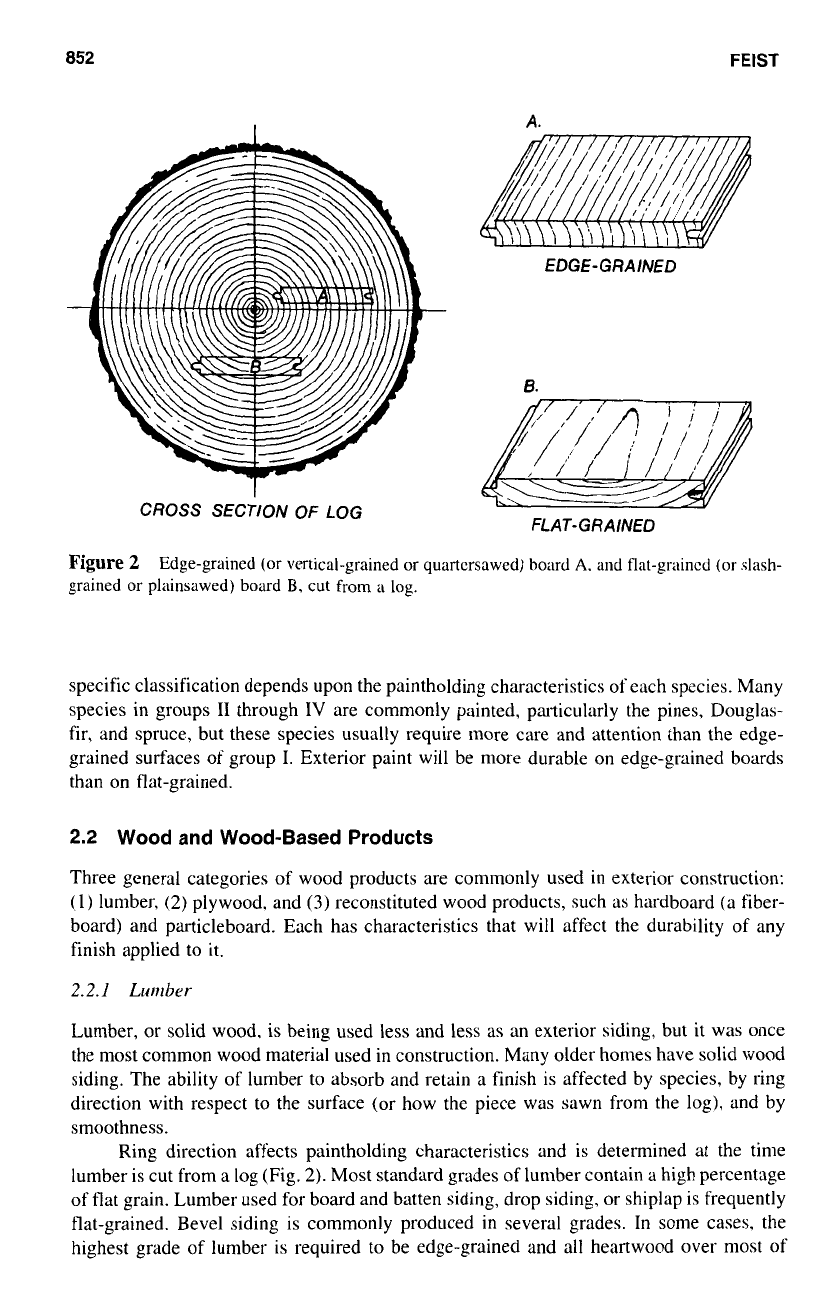
852
A.
FElST
EDGE-GRAINED
B.
CROSS SECTION
OF
LOG
FLAT-GRAINED
Figure
2
Edge-grained
(or
vertical-grained
or
quartcrsawed) board
A.
and
flat-graincd
(or
slash-
grained or
plainsawed)
board
B,
cut
from
a
log.
specific classification depends upon the paintholding characteristics
of
each species. Many
species in groups
I1
through
IV
are commonly painted, particularly the pines, Douglas-
fir, and spruce, but these species usually require more care and attention than the edge-
grained surfaces of group
I.
Exterior paint will be more durable
on
edge-grained boards
than on flat-grained.
2.2 Wood
and
Wood-Based
Products
Three general categories of wood products are commonly used in exterior construction:
(1)
lumber,
(2)
plywood. and
(3)
reconstituted wood products, such as hardboard (a fiber-
board) and particleboard. Each has characteristics that will affect the durability of any
finish applied to it.
2.2.1
Lumber
Lumber, or solid wood, is being used less and less
as
an exterior siding, but it was once
the most common wood material used in construction. Many older homes have solid wood
siding. The ability of lumber to absorb and retain a finish is affected by species, by ring
direction with respect
to
the surface (or how the piece was sawn from the log), and by
smoothness.
Ring direction affects paintholding characteristics and is determined at the time
lumber is cut from a
log
(Fig.
2).
Most standard grades of lumber contain a high percentage
of
flat grain. Lumber used for board and batten siding, drop siding, or shiplap is frequently
flat-grained. Bevel siding is commonly produced
in
several grades.
In
some cases, the
highest grade
of
lumber is required
to
be edge-grained and all heartwood over most
of
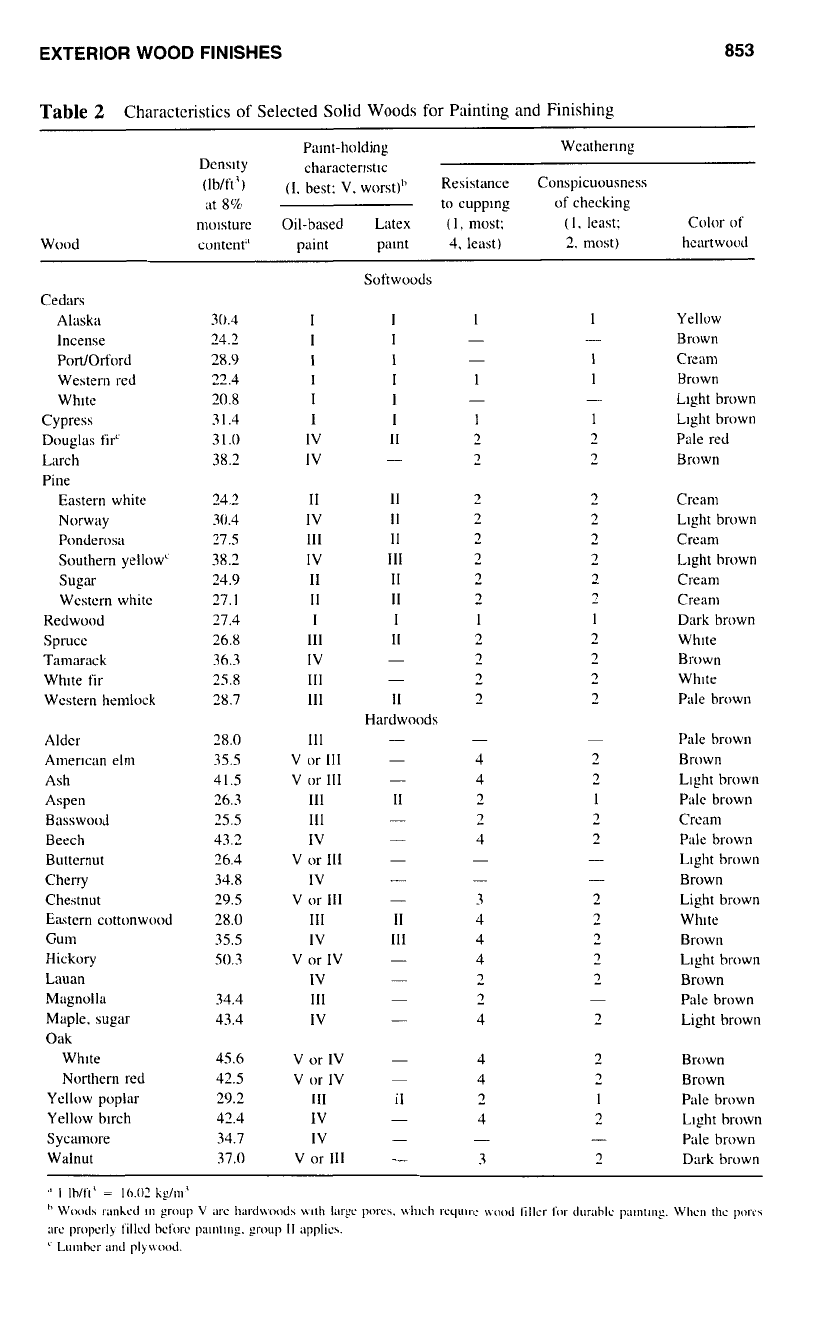
EXTERIOR
WOOD
FINISHES
853
Table
2
Charactcristics
of
Selected Solid
Woods
for Painting
and
Finishing
Pam-holding Wcatherlng
Dcnslty
(Ib/ft')
(1.
best:
V,
worst)t~
Resistance Conspicuousness
characterlstlc
at
8%
to cupplng of checking
nwsture Oil-based Latex
(
I,
nut:
(I.
least: Color
of
Wood
content" paint pamt
4*
least)
2.
most) heartwood
Cedars
Alaska
Incense
Podorford
Western red
Whltc
Cypress
Douglas fir'
Larch
Pine
Eastern white
Norway
Ponderosa
Southern yellow'
Sugar
Western white
Redwood
Spruce
Tamarack
Whlte fir
Wcstern hemlock
Alder
Amerlcan elm
Ash
Aspen
Beech
Butternut
Cherry
Chestnut
Eastern cottonwood
Gum
Hickory
Lauan
Magnolln
Maple. sugar
Oak
B, 'Isswood
..
Whlte
Northern red
Yellow poplar
Yellow blrch
Sycamore
Walnut
30.4
24.2
28.9
22.4
20.8
3
I
.4
3
I
.o
38.2
24.2
30.4
27.5
38.2
24.9
27.1
27.4
26.8
36.3
25.8
28.7
28.0
35.5
41.5
26.3
25.5
43.2
26.4
34.8
29.5
28.0
35.5
50.3
34.4
43.4
45.6
42.5
29.2
42.4
34.7
37.0
Softwoods
I
I
I
I
I
l
I
I
I
1
I
I
IV
I1
IV
-
I1
II
IV
II
111
II
IV
111
II
II
II
II
I
1
111
II
IV
111
111
I1
Hardwoods
-
-
111
V
or
Ill
v
or
111
-
-
-
111
II
111
IV
V
or
111
IV
__
-
-
-
V
or
111
-
Ill
II
IV
111
V
or
IV
IV
Ill
IV
-
__
-
-
V
or
IV
-
V
or
IV
~
111
II
IV
IV
V
or
111
-
-
-
Yellow
Brown
Cream
Brown
Llght brown
Llght brown
Pale red
Brown
Cream
Llght brown
Crenm
Llght brown
Cream
Cream
Dark
brown
Whlte
Brown
Whlte
Pale brown
Pale brown
Brown
Llght brown
Pale
brown
Crcam
Pale
brown
Llght brown
Brown
Light brown
White
Brown
Llght brown
Brown
Pale brown
Light brown
Brown
Brown
Pale
brown
Llght brown
Pale
brown
Dark brown
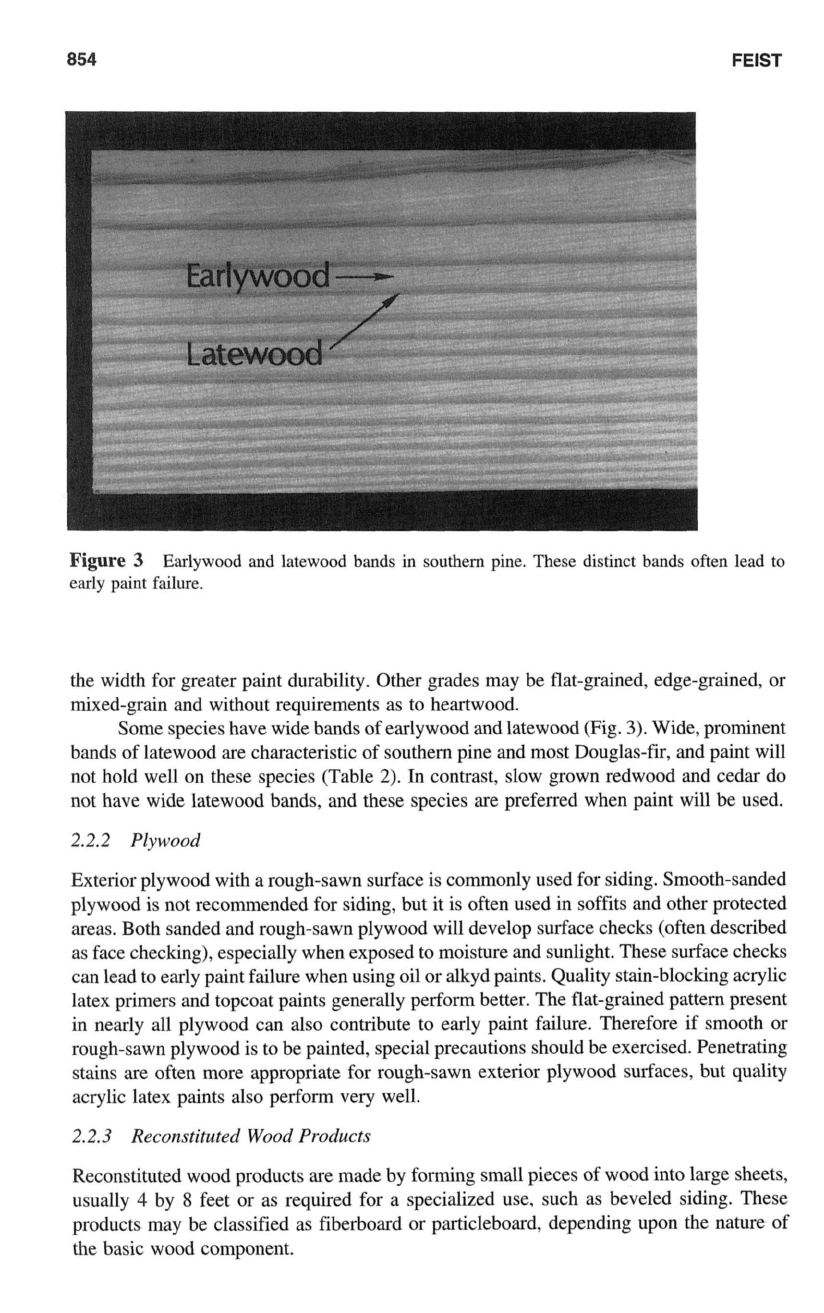
854
FElST
Figure
3
Earlywood and latewood bands in southern pine. These distinct bands often lead to
early paint failure.
the width for greater paint durability. Other grades may be flat-grained, edge-grained,
or
mixed-grain and without requirements as to heartwood.
Some species have wide bands of earlywood and latewood (Fig.
3).
Wide, prominent
bands of latewood
are
characteristic of southern pine and most Douglas-fir, and paint will
not hold well on these species (Table
2).
In contrast, slow grown redwood and cedar do
not have wide latewood bands, and these species are preferred when paint will be used.
2.2.2
Plywood
Exterior plywood with a rough-sawn surface is commonly used for siding. Smooth-sanded
plywood is not recommended for siding, but it is often used
in
soffits and other protected
areas. Both sanded and rough-sawn plywood will develop surface checks (often described
as face checking), especially when exposed to moisture and sunlight. These surface checks
can lead to early paint failure when using oil
or
alkyd paints. Quality stain-blocking acrylic
latex primers and topcoat paints generally perform better. The flat-grained pattern present
in nearly all plywood can
also
contribute to early paint failure. Therefore if smooth
or
rough-sawn plywood is to be painted, special precautions should be exercised. Penetrating
stains are often more appropriate for rough-sawn exterior plywood surfaces, but quality
acrylic latex paints also perform very well.
2.2.3
Reconstituted Wood Products
Reconstituted wood products are made by forming small pieces of wood into large sheets,
usually
4
by
8
feet
or
as required for a specialized use. such as beveled siding. These
products may be classified as fiberboard
or
particleboard, depending upon the nature of
the basic wood component.
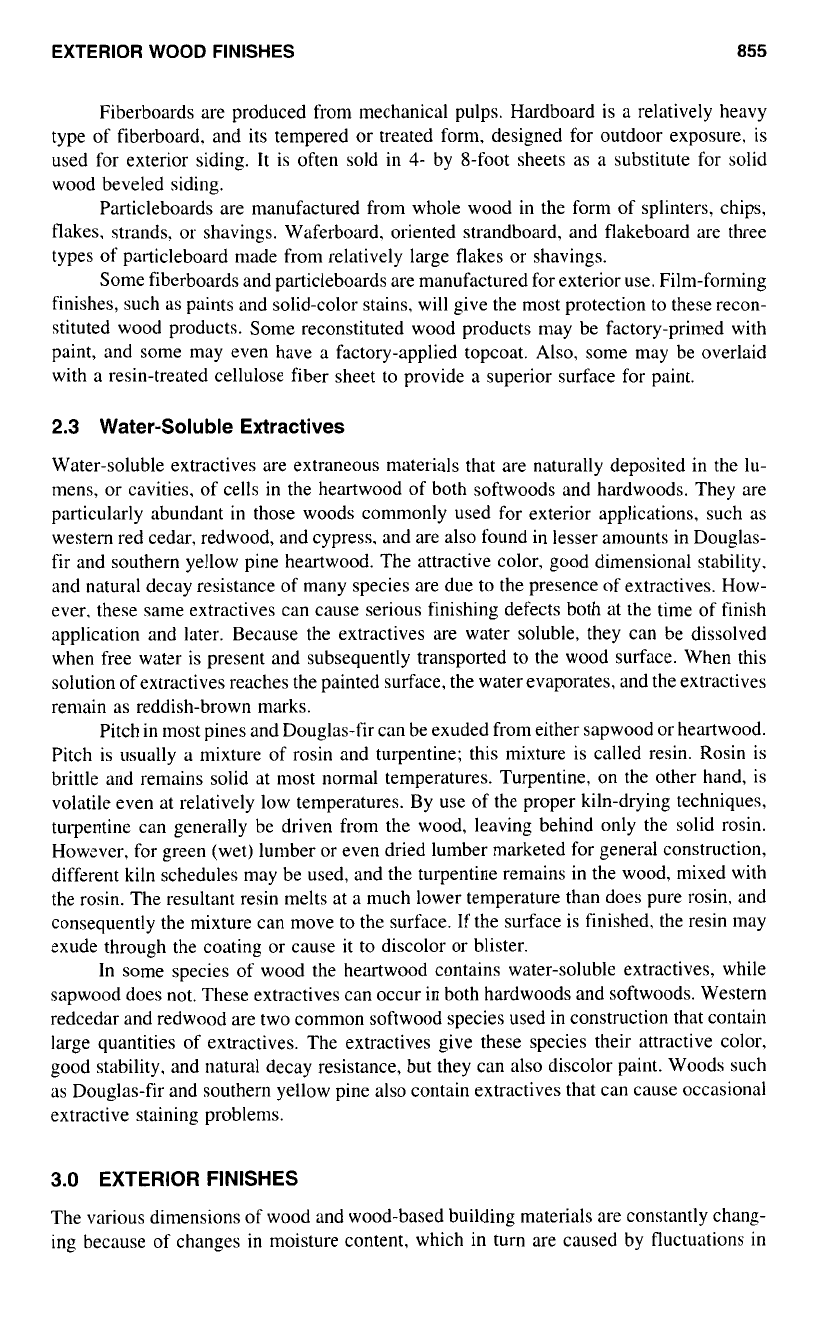
EXTERIOR
WOOD
FINISHES
855
Fiberboards are produced from mechanical pulps. Hardboard is a relatively heavy
type of fiberboard. and its tempered or treated form, designed for outdoor exposure. is
used for exterior siding. It is often sold in
4-
by Hoot sheets as
a
substitute for solid
wood beveled siding.
Particleboards are manufactured from whole wood in the form
of
splinters, chips,
flakes. strands.
or
shavings. Waferboard. oriented strandboard, and flakeboard are three
types
of
particleboard made from relatively large flakes or shavings.
Some fiberboards and particleboards are manufactured for exterior use. Film-forming
finishes, such as paints and solid-color stains. will give the most protection to these recon-
stituted wood products. Some reconstituted wood products may be factory-primed with
paint, and some may even have
a
factory-applied topcoat.
Also,
some may be overlaid
with
a
resin-treated cellulose fiber sheet to provide
a
superior surface for paint.
2.3
Water-Soluble Extractives
Water-soluble extractives are extraneous materials that are naturally deposited in the lu-
mens, or cavities, of cells
in
the heartwood of both softwoods and hardwoods. They are
particularly abundant
in
those woods commonly used for exterior applications, such
as
western red cedar, redwood, and cypress. and are
also
found in lesser amounts in Douglas-
fir and southern yellow pine heartwood. The attractive color, good dimensional stability,
and natural decay resistance of many species are due to the presence of extractives. How-
ever. these same extractives can cause serious finishing defects both at the time of finish
application and later. Because the extractives are water soluble, they can be dissolved
when free water is present and subsequently transported to the wood surface. When this
solution
of
extractives reaches the painted surface, the water evaporates, and the extractives
remain
as
reddish-brown marks.
Pitch in most pines and Douglas-fir can be exuded from either sapwood or heartwood.
Pitch is usually
a
mixture of rosin and turpentine; this mixture is called resin. Rosin is
brittle and remains solid at most normal temperatures. Turpentine, on the other hand, is
volatile even at relatively low temperatures. By use
of
the proper kiln-drying techniques,
turpentine can generally be driven from the wood, leaving behind only the solid rosin.
However, for green (wet) lumber or even dried lumber marketed for general construction,
different kiln schedules may be used, and the turpentine remains in the wood, mixed with
the rosin. The resultant resin melts at a much lower temperature than does pure rosin. and
consequently the mixture can move
to
the surface. If the surface is finished, the resin may
exude through the coating or cause
it
to
discolor or blister.
In
some species
of
wood the heartwood contains water-soluble extractives, while
sapwood does not. These extractives can occur in both hardwoods and softwoods. Western
redcedar and redwood are two common softwood species used
in
construction that contain
large quantities of extractives. The extractives give these species their attractive color,
good stability, and natural decay resistance, but they can also discolor paint. Woods such
as Douglas-fir and southern yellow pine
also
contain extractives that can cause occasional
extractive staining problems.
3.0
EXTERIOR
FINISHES
The various dimensions of wood and wood-based building materials are constantly chang-
ing because of changes
in
moisture content, which in turn are caused by fluctuations in
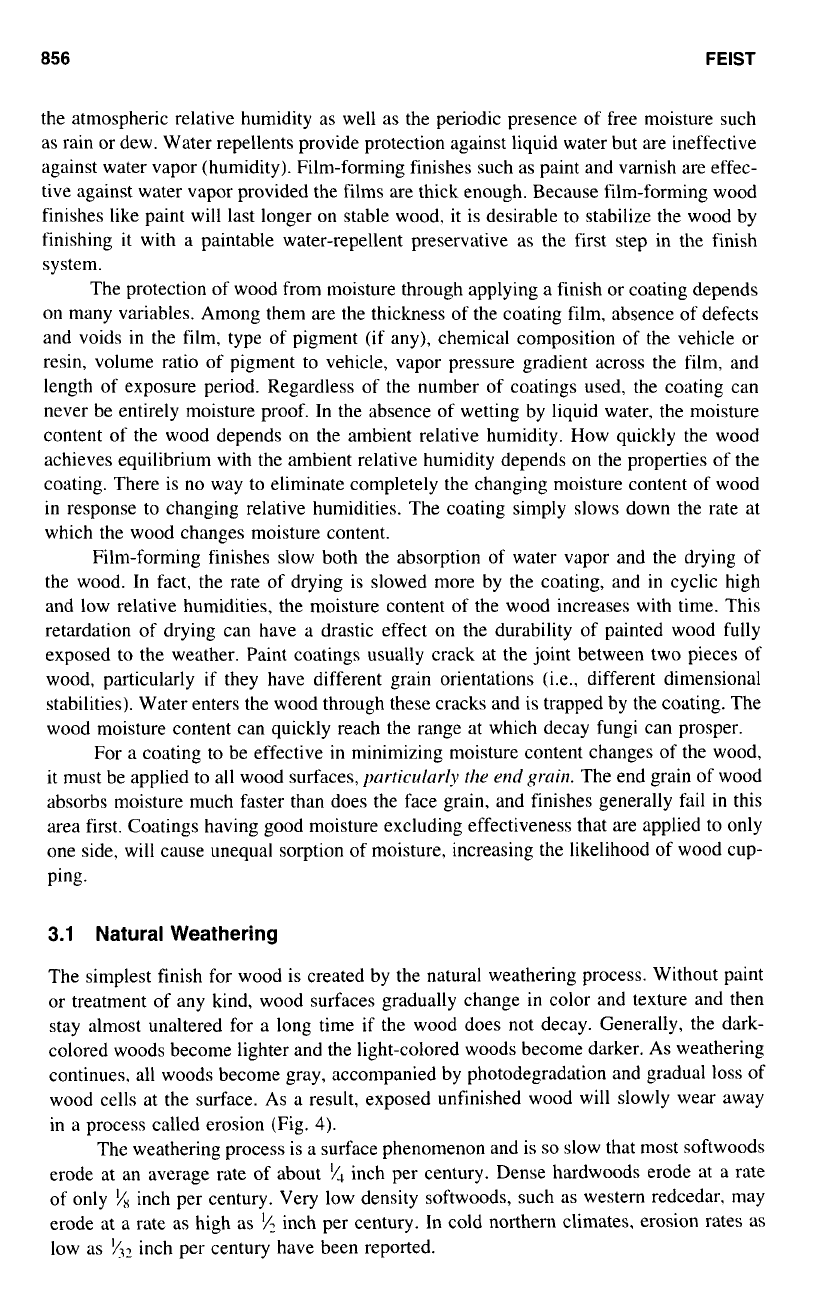
856
FEET
the atmospheric relative humidity as well
as
the periodic presence of free moisture such
as
rain or dew. Water repellents provide protection against liquid water but are ineffective
against water vapor (humidity). Film-forming finishes such
as
paint and varnish are effec-
tive against water vapor provided the films are thick enough. Because film-forming wood
finishes like paint will last longer on stable wood, it
is
desirable to stabilize the wood by
finishing it with
a
paintable water-repellent preservative
as
the first step in the finish
system.
The protection of wood from moisture through applying
a
finish or coating depends
on
many variables. Among them are the thickness of the coating film, absence of defects
and voids in the film, type of pigment (if any), chemical composition
of
the vehicle or
resin, volume ratio of pigment to vehicle, vapor pressure gradient across the film, and
length of exposure period. Regardless of the number of coatings used, the coating can
never be entirely moisture proof. In the absence of wetting by liquid water, the moisture
content
of
the wood depends on the ambient relative humidity. How quickly the wood
achieves equilibrium with the ambient relative humidity depends on the properties of the
coating. There is no way to eliminate completely the changing moisture content of wood
in response to changing relative humidities. The coating simply slows down the rate at
which the wood changes moisture content.
Film-forming finishes slow both the absorption of water vapor and the drying
of
the wood. In fact, the rate of drying is slowed more by the coating, and
in
cyclic high
and low relative humidities, the moisture content
of
the wood increases with time. This
retardation of drying can have a drastic effect
on
the durability of painted wood fully
exposed to the weather. Paint coatings usually crack at the joint between two pieces of
wood, particularly
if
they have different grain orientations (i.e., different dimensional
stabilities). Water enters the wood through these cracks and is trapped by the coating. The
wood moisture content can quickly reach the range at which decay fungi can prosper.
For a coating to be effective in minimizing moisture content changes of the wood,
it must be applied to all wood surfaces,
prticulurl~~ the
erld
grl1in.
The end grain
of
wood
absorbs moisture much faster than does the face grain, and finishes generally fail
in
this
area first. Coatings having good moisture excluding effectiveness that are applied to only
one side, will cause unequal sorption
of
moisture, increasing the likelihood of wood cup-
ping.
3.1
Natural Weathering
The simplest finish for wood is created by the natural weathering process. Without paint
or treatment of any kind, wood surfaces gradually change
in
color and texture and then
stay almost unaltered for
a
long time if the wood does not decay. Generally, the dark-
colored woods become lighter and the light-colored woods become darker. As weathering
continues. all woods become gray, accompanied by photodegradation and gradual loss of
wood cells at the surface. As a result, exposed unfinished wood will slowly wear away
in a process called erosion (Fig.
4).
The weathering process is
a
surface phenomenon and is
so
slow that most softwoods
erode at
an
average rate of about
!l4
inch per century. Dense hardwoods erode at
a
rate
of
only
!l8
inch per century. Very low density softwoods, such as western redcedar. may
erode at
a
rate as high
as
v'-
inch per century. In cold northern climates, erosion rates as
low
as
!+
inch per century have been reported.
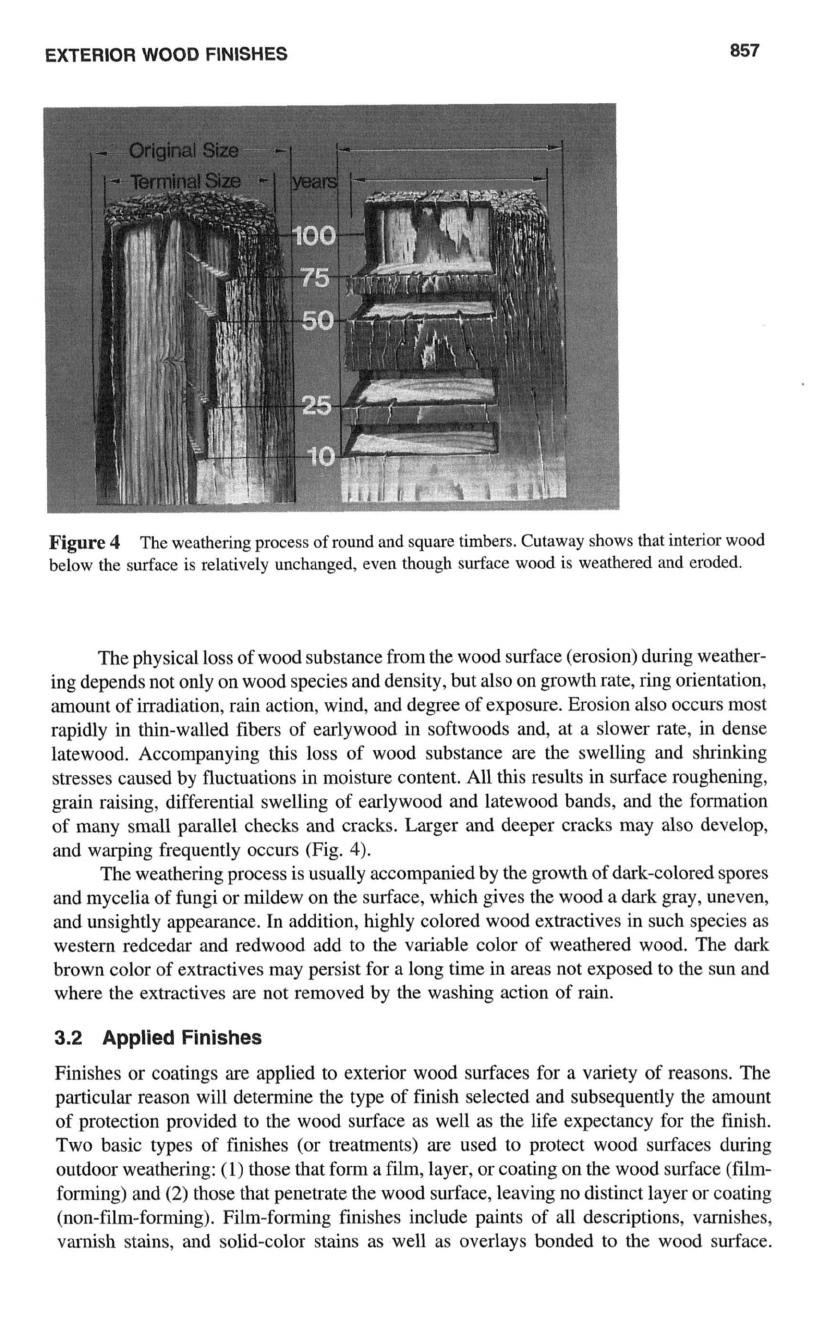
EXTERIOR WOOD
FINISHES
857
Figure
4
The weathering process
of
round and square timbers. Cutaway shows that interior wood
below the surface is relatively unchanged, even though surface wood
is
weathered and eroded.
The physical loss of wood substance from the wood surface (erosion) during weather-
ing depends not only on wood species and density, but also on growth rate, ring orientation,
amount of irradiation, rain action, wind, and degree of exposure. Erosion also occurs most
rapidly in thin-walled fibers of earlywood in softwoods and, at a slower rate, in dense
latewood. Accompanying this loss of wood substance are the swelling and shrinking
stresses caused by fluctuations in moisture content. All this results in surface roughening,
grain raising, differential swelling of earlywood and latewood bands, and the formation
of many small parallel checks and cracks. Larger and deeper cracks may also develop,
and warping frequently occurs (Fig.
4).
The weathering process is usually accompanied by the growth of dark-colored spores
and mycelia of fungi
or
mildew on the surface, which gives the wood a dark gray, uneven,
and unsightly appearance. In addition, highly colored wood extractives in such species as
western redcedar and redwood add to the variable color of weathered wood. The dark
brown color of extractives may persist for a long time in areas not exposed to the sun and
where the extractives are not removed by the washing action of rain.
3.2
Applied Finishes
Finishes
or
coatings are applied to exterior wood surfaces for a variety of reasons. The
particular reason will determine the type of finish selected and subsequently the amount
of protection provided to the wood surface as well as the life expectancy for the finish.
Two basic types of finishes
(or
treatments) are used to protect wood surfaces during
outdoor weathering:
(1)
those that form a film, layer,
or
coating on the wood surface (film-
forming) and
(2)
those that penetrate the wood surface, leaving no distinct layer
or
coating
(non-film-forming). Film-forming finishes include paints of all descriptions, varnishes,
varnish stains, and solid-color stains as well as overlays bonded to the wood surface.
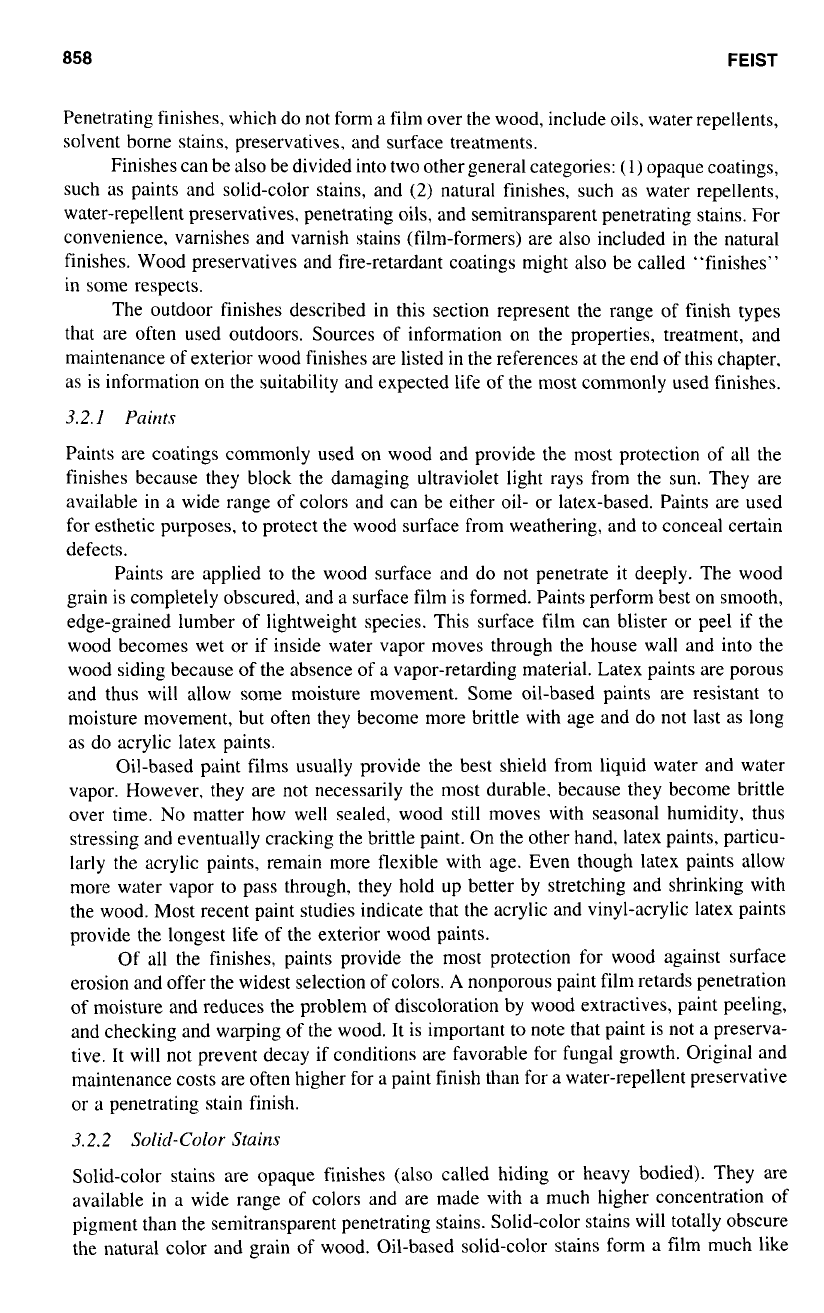
858
FEET
Penetrating finishes, which do not form
a
film over the wood, include oils, water repellents,
solvent borne stains, preservatives, and surface treatments.
Finishes can be also be divided into two other general categories:
(1)
opaque coatings,
such
as
paints and solid-color stains, and
(2)
natural finishes, such
as
water repellents,
water-repellent preservatives, penetrating oils, and semitransparent penetrating stains. For
convenience, varnishes and varnish stains (film-formers) are also included in the natural
finishes. Wood preservatives and fire-retardant coatings might
also
be called “finishes”
in some respects.
The outdoor finishes described
in
this section represent the range of finish types
that are often used outdoors. Sources of information on the properties, treatment, and
maintenance of exterior wood finishes are listed in the references at the end of this chapter.
as
is information on the suitability and expected life of the most commonly used finishes.
3.2.1
Paints
Paints are coatings commonly used
on
wood and provide the most protection of all the
finishes because they block the damaging ultraviolet light rays from the sun. They are
available in a wide range
of
colors and can be either oil- or latex-based. Paints are used
for esthetic purposes, to protect the wood surface from weathering, and to conceal certain
defects.
Paints are applied to the wood surface and do not penetrate it deeply. The wood
grain is completely obscured, and a surface film is formed. Paints perform best on smooth,
edge-grained lumber of lightweight species. This surface film can blister or peel if the
wood becomes wet or if inside water vapor moves through the house wall and into the
wood siding because of the absence of a vapor-retarding material. Latex paints are porous
and thus will allow some moisture movement. Some oil-based paints are resistant to
moisture movement, but often they become more brittle with age and do not last
as
long
as do acrylic latex paints.
Oil-based paint films usually provide the best shield from liquid water and water
vapor. However, they are not necessarily the most durable, because they become brittle
over time.
No
matter how well sealed, wood still moves with seasonal humidity, thus
stressing and eventually cracking the brittle paint. On the other hand. latex paints, particu-
larly the acrylic paints, remain more flexible with age. Even though latex paints allow
more
water vapor
to
pass through, they hold up better by stretching and shrinking with
the wood. Most recent paint studies indicate that the acrylic and vinyl-acrylic latex paints
provide the longest life of the exterior wood paints.
Of all the finishes, paints provide the most protection for wood against surface
erosion and offer the widest selection
of
colors.
A
nonporous paint film retards penetration
of moisture and reduces the problem of discoloration by wood extractives, paint peeling,
and checking and warping of the wood. It is important
to
note that paint is not
a
preserva-
tive. It will not prevent decay if conditions are favorable for fungal growth. Original and
maintenance costs are often higher for
a
paint finish than for
a
water-repellent preservative
or
a
penetrating stain finish.
3.2.2
Solicl-Color Stains
Solid-color stains are opaque finishes
(also
called hiding or heavy bodied). They are
available in
a
wide range of colors and are made with a much higher concentration
of
pigment than the semitransparent penetrating stains. Solid-color stains will totally obscure
the natural color and grain
of
wood. Oil-based solid-color stains form
a
film much like
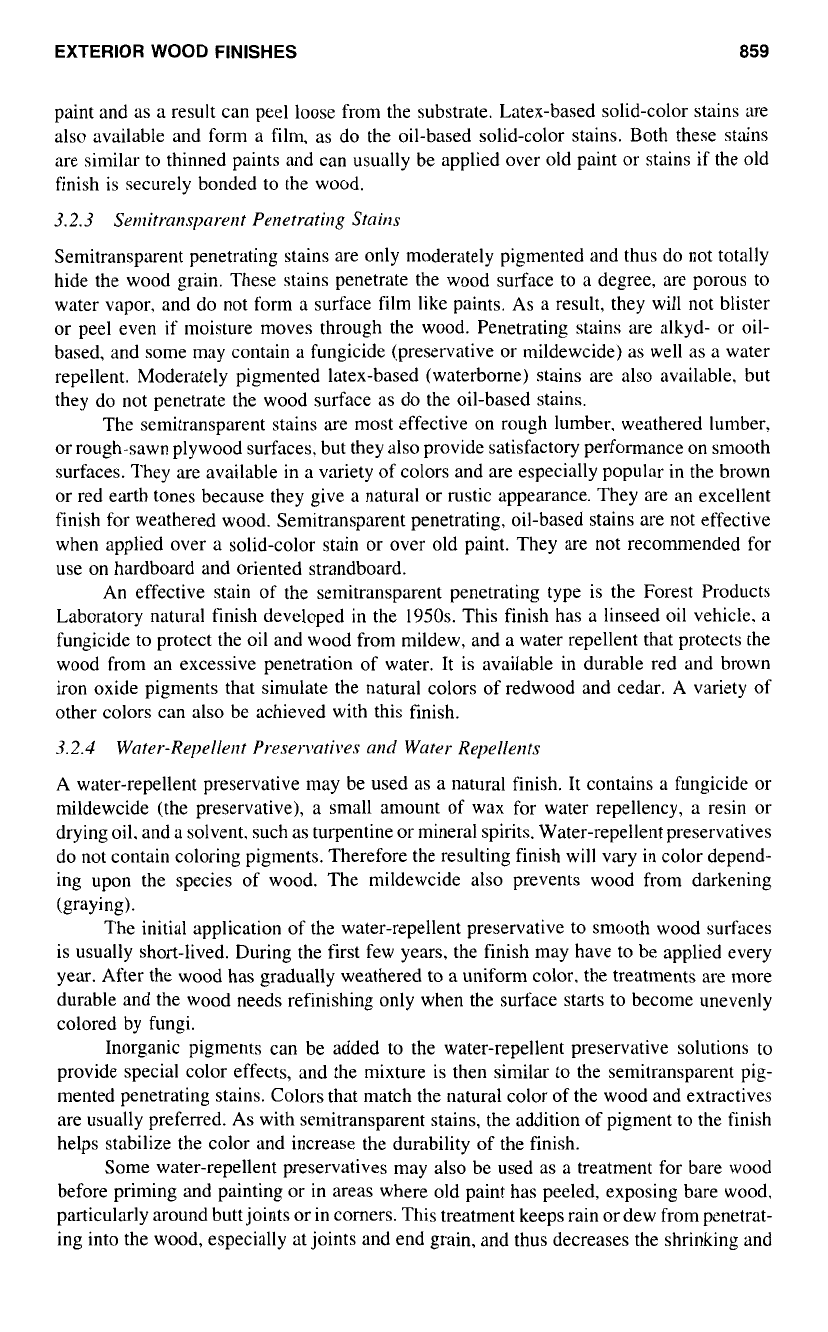
EXTERIOR
WOOD
FINISHES 859
paint and as a result can peel loose from the substrate. Latex-based solid-color stains are
also
available and form
a
film.
as
do the oil-based solid-color stains. Both these stains
are similar to thinned paints and can usually be applied over old paint or stains if the old
finish is securely bonded to the wood.
3.2.3
Senlitransl~a~e~lt
Penetrating Stclirls
Semitransparent penetrating stains are only moderately pigmented and thus do not totally
hide the wood grain. These stains penetrate the wood surface to
a
degree, are porous
to
water vapor, and do not form a surface film like paints. As
a
result, they will not blister
or peel even
if
moisture moves through the wood. Penetrating stains are alkyd- or oil-
based, and some may contain
a
fungicide (preservative or mildewcide) as well
as
a
water
repellent. Moderately pigmented latex-based (waterborne) stains are also available, but
they do not penetrate the wood surface as do the oil-based stains.
The semitransparent stains are most effective on rough lumber. weathered lumber.
or rough-sawn plywood surfaces. but they also provide satisfactory performance on smooth
surfaces. They are available in
a
variety of colors and are especially popular in the brown
or red earth tones because they give a natural or rustic appearance. They are an excellent
finish for weathered wood. Semitransparent penetrating, oil-based stains are not effective
when applied over a solid-color stain or over old paint. They are not recommended for
use on hardboard and oriented strandboard.
An effective stain of the semitransparent penetrating type is the Forest Products
Laboratory natural finish developed in the
1950s.
This finish has a linseed oil vehicle.
a
fungicide to protect the
oil
and wood from mildew, and
a
water repellent that protects the
wood from an excessive penetration of water. It is available in durable red and brown
iron oxide pigments that simulate the natural colors of redwood and cedar. A variety
of
other colors can
also
be achieved with this finish.
3.2.4 Water-Repellent Preservati\~e.s
and
Water Repellents
A water-repellent preservative may be used as
a
natural finish. It contains
a
fungicide or
mildewcide (the preservative),
a
small amount of wax for water repellency, a resin or
drying oil. and a solvent. such as turpentine or mineral spirits. Water-repellent preservatives
do not contain coloring pigments. Therefore the resulting finish will vary in color depend-
ing upon the species of wood. The mildewcide also prevents wood from darkening
(graying).
The initial application of the water-repellent preservative to smooth wood surfaces
is usually short-lived. During the first few years, the finish may have to be applied every
year. After the wood has gradually weathered to
a
uniform color, the treatments are more
durable and the wood needs refinishing only when the surface starts to become unevenly
colored by fungi.
Inorganic pigments can be added to the water-repellent preservative solutions
to
provide special color effects, and the mixture is then similar to the semitransparent pig-
mented penetrating stains. Colors that match the natural color of the wood and extractives
are usually preferred.
As
with semitransparent stains, the addition of pigment to the finish
helps stabilize the color and increase the durability of the finish.
Some water-repellent preservatives may also be used
as
a
treatment for bare wood
before priming and painting or
in
areas where old paint has peeled, exposing bare wood,
particularly around butt joints or in comers. This treatment keeps rain or dew from penetrat-
ing into the wood, especially at joints and end grain, and thus decreases the shrinking and
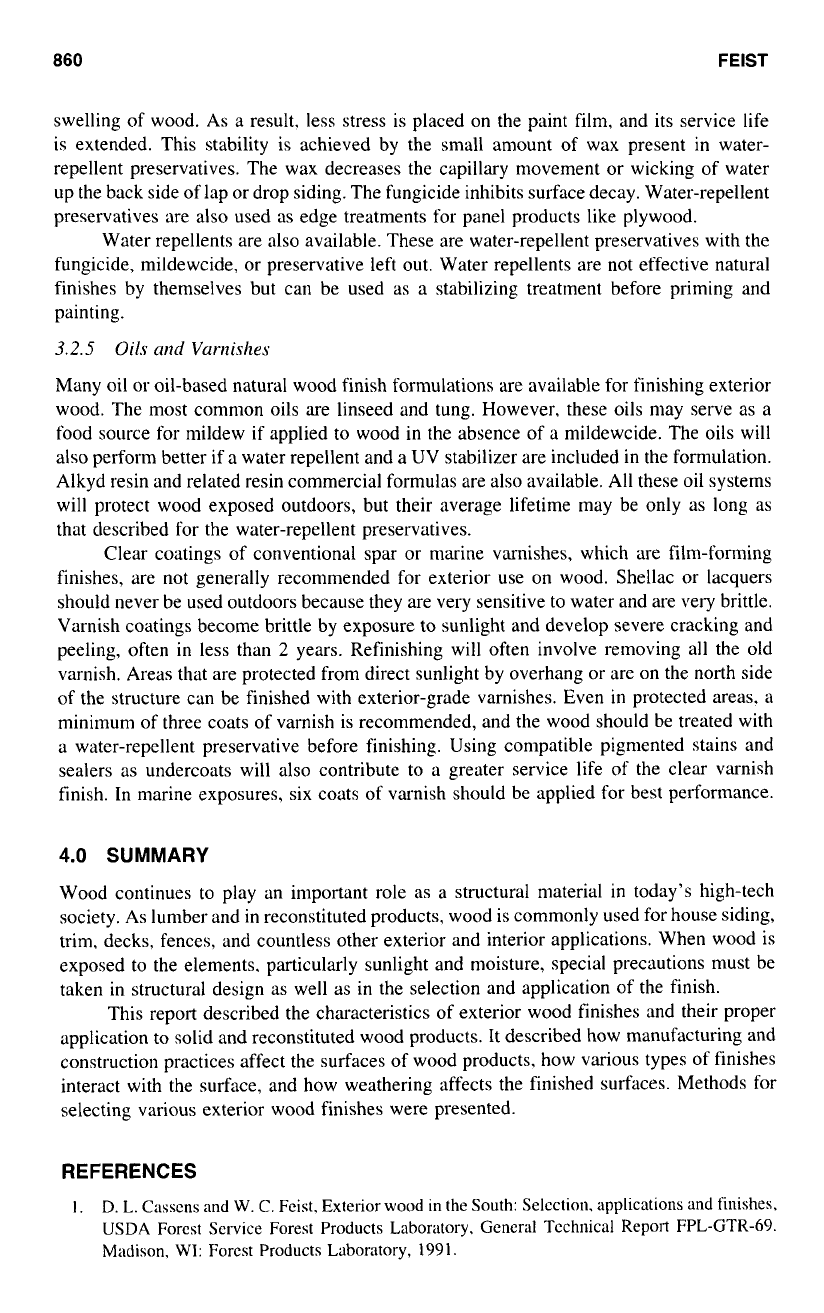
860
FEET
swelling
of
wood. As a result. less stress is placed on the paint film, and its service life
is extended. This stability is achieved by the small amount
of
wax present in water-
repellent preservatives. The wax decreases the capillary movement or wicking of water
up the back side
of
lap or drop siding. The fungicide inhibits surface decay. Water-repellent
preservatives are also used as edge treatments for panel products like plywood.
Water repellents are also available. These are water-repellent preservatives with the
fungicide, mildewcide, or preservative left out. Water repellents are
not
effective natural
finishes by themselves but can be used as a stabilizing treatment before priming and
painting.
3.2.5
Oils
and
Vurnishes
Many oil or oil-based natural wood finish formulations are available for finishing exterior
wood. The most common oils are linseed and tung. However, these oils may serve as a
food source for mildew
if
applied
to
wood in the absence of a mildewcide. The oils will
also perform better if a water repellent and a UV stabilizer are included in the formulation.
Alkyd resin and related resin commercial formulas are also available.
All
these oil systems
will protect wood exposed outdoors, but their average lifetime may be only as long as
that described for the water-repellent preservatives.
Clear coatings of conventional spar or marine varnishes, which are film-forming
finishes, are not generally recommended for exterior use on wood. Shellac or lacquers
should never be used outdoors because they are very sensitive
to
water and are very brittle.
Varnish coatings become brittle by exposure to sunlight and develop severe cracking and
peeling, often
in
less than
2
years. Refinishing will often involve removing all the old
varnish. Areas that are protected from direct sunlight by overhang or are on the north side
of
the structure can be finished with exterior-grade varnishes. Even in protected areas.
a
minimum
of
three coats of varnish is recommended, and the wood should be treated with
a water-repellent preservative before finishing. Using compatible pigmented stains and
sealers as undercoats will also contribute to a greater service life
of
the clear varnish
finish. In marine exposures, six coats of varnish should be applied for best performance.
4.0
SUMMARY
Wood continues to play an important role as a structural material in today’s high-tech
society. As lumber and
in
reconstituted products, wood is commonly used for house siding,
trim, decks, fences, and countless other exterior and interior applications. When wood is
exposed to the elements. particularly sunlight and moisture, special precautions must be
taken in structural design as well as in the selection and application of the finish.
This report described the characteristics of exterior wood finishes and their proper
application to solid and reconstituted wood products. It described how manufacturing and
construction practices affect the surfaces of wood products, how various types of finishes
interact with the surface, and how weathering affects the finished surfaces. Methods for
selecting various exterior wood finishes were presented.
REFERENCES
I.
D.
L.
Cnsscns and
W.
C.
Feist, Exterior wood in the South: Selcction, applications and finishes,
USDA
Forest Service Forest Products Laboratory. General Technical Report FPL-GTR-69.
Madison,
WI:
Forest Products Laboratory, 1991.
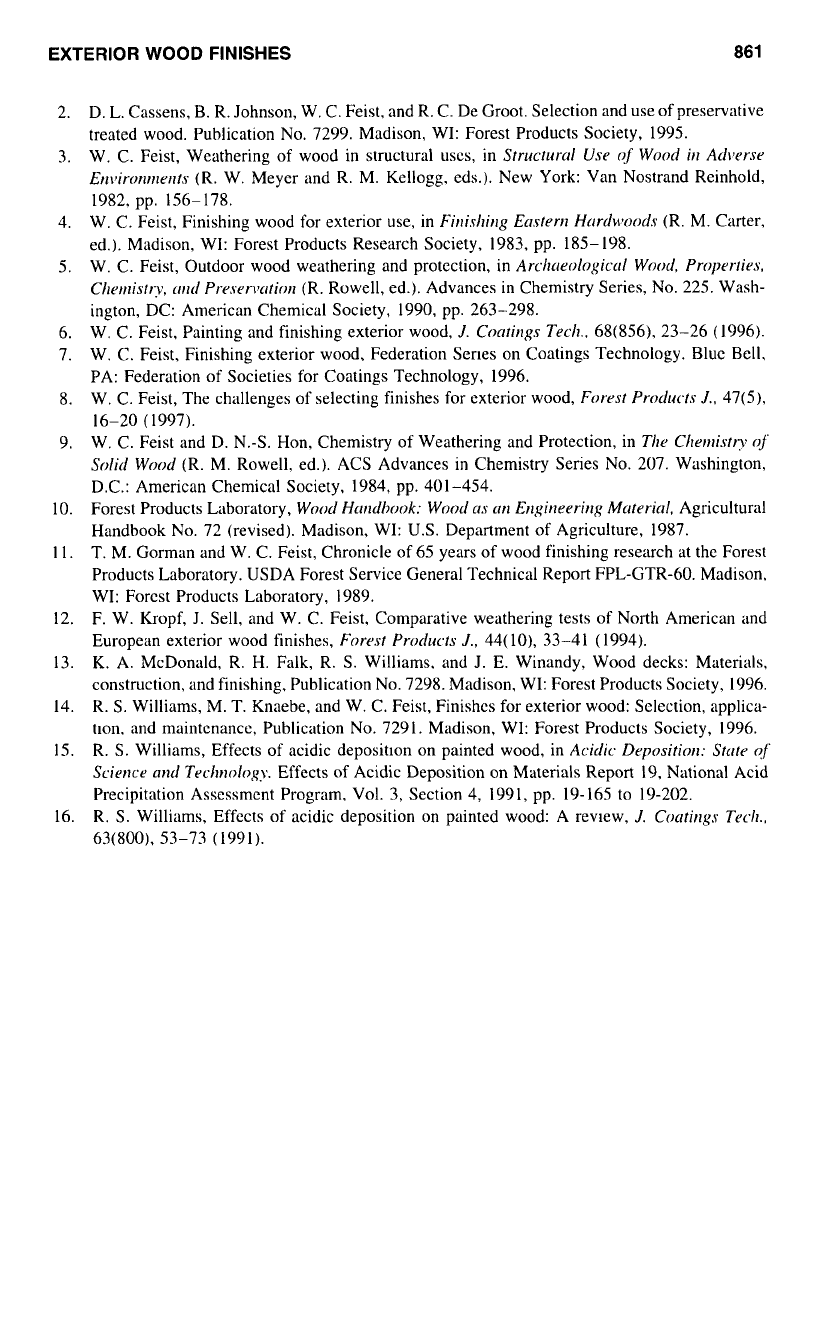
EXTERIOR WOOD
FINISHES 861
2.
3.
4.
5.
6.
7.
8.
9.
IO.
11.
12.
13.
14.
IS.
16.
D. L. Cassens, B. R. Johnson, W. C. Feist. and R. C. De Groot. Selection and use of preservative
treated wood. Publication No. 7299. Madison, WI: Forest Products Society, 1995.
W. C. Feist, Weathering of wood in structural uscs, in
Structrcrrrl
Use
of Wood
in
Adverse
Envirorvrterl/.s
(R.
W. Meyer and
R.
M. Kellogg, eds.). New York: Van Nostrand Reinhold,
W. C. Feist, Finishing wood for exterior use,
in
Fir~ishir~g
Eastern
H~trc/n~ood.s
(R. M. Carter,
ed.). Madison, WI: Forest Products Research Society, 1983, pp. 185-198.
W. C. Feist, Outdoor wood weathering and protection, in
Archcreologicd
Wood,
Properties.
C/lerrlisr,y
NII~
Presenutiorl
(R. Rowell, ed.). Advances
in
Chemistry Series,
No.
225. Wash-
ington, DC: American Chemical Society, 1990, pp. 263-298.
W. C. Feist, Painting and finishing exterior wood,
J.
Coatings
Tech..
68(856), 23-26 (1996).
W. C. Feist, Finishing exterior wood, Federation Serles on Coatings Technology. Bluc Bell,
PA: Federation of Societies for Coatings Technology, 1996.
W. C. Feist, The challenges of selecting finishes
for
exterior wood,
Forest
Products
J..
47(5),
16-20 (1997).
W. C. Feist and D. N.-S. Hon, Chemistry of Weathering and Protection, in
The
C/lerni.stt>>
Solid
Wood
(R. M. Rowell, ed.). ACS Advances in Chemistry Series
No.
207. Washington,
DC.: American Chemical Society, 1984, pp. 401-454.
Forest Products Laboratory,
Wood
Hmdbook:
Wood
NS
mt
Gtgir~wir~g
Mrrtericd.
Agricultural
Handbook
No.
72 (revised). Madison, WI: U.S. Department of Agriculture, 1987.
T. M. Gorman and W. C. Feist, Chronicle of
65
years of wood finishing research at the Forest
Products Laboratory. USDA Forest Service General Technical Report FPL-GTR-60. Madison,
WI: Forest Products Laboratory, 1989.
F. W. Kropf,
J.
Sell, and W. C. Feist, Comparative weathering tests of North American and
European exterior wood finishes,
Forest
Prodtccts
J.,
44(
IO),
33-41 (1994).
K.
A. McDonald, R. H. Falk, R.
S.
Williams. and J. E. Winandy, Wood decks: Materials,
construction, and finishing, Publication No. 7298. Madison, WI: Forest Products Society, 1996.
R.
S.
Williams, M. T. Knaebe, and W. C. Feist, Finishcs for exterior wood: Sclection, applica-
tlon. and maintenance, Publication No. 7291. Madison, WI: Forest Products Society, 1996.
R.
S.
Williams, Effects
of
acidic depositlon on painted wood, in
Acidic
Deposition:
Sttrte
of’
Science
and
Tec/~nolo,~p.
Effects of Acidic Deposition on Materials Report
19,
National Acid
Precipitation Assessment Program. Vol. 3, Section 4, 1991, pp. 19-165 to 19-202.
R.
S.
Williams, Effects of acidic deposition on paintcd wood:
A
revlew,
J.
Cocrtings
Tech.,
1982, pp. 156-178.
63(800),
53-73 (1991).
